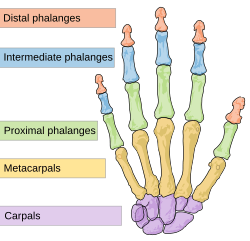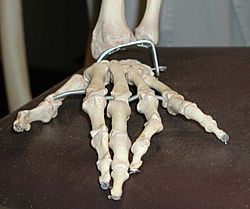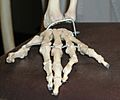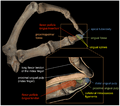Phalanges facts for kids
| Bone: Phalanx bone | ||
|---|---|---|
| Illustration of the phalanges | ||
| The phalanges in a human hand | ||
| Latin | phalanx pl. phalanges |
|
| Articulations | Metacarpophalangeal, metatarsophalangeal, interphalangeal | |
Phalanges (say: fuh-LAN-jeez) are the bones that make up your fingers and toes. You have 14 phalanges in each hand and 14 in each foot. This means you have a total of 56 phalanges in your body! These small bones are super important for helping you grab things, walk, and keep your balance.
Contents
What are Phalanges?
Phalanges are long bones, even though they are quite small. They are named based on their position.
- The ones closest to your palm or foot are called proximal phalanges.
- The ones in the middle are middle phalanges.
- The ones at the very tips of your fingers and toes are distal phalanges.
Your thumb and big toe are special! They only have two phalanges: a proximal and a distal one. All your other fingers and toes have three: proximal, middle, and distal.
Phalanges in Your Hands
The phalanges in your hands are commonly known as your fingers. They help you do amazing things like writing, playing sports, and holding your phone. Each finger, except your thumb, has three bones. Your thumb has two. These bones work together to let you bend and straighten your fingers. This movement is possible because of the joints between the phalanges.
Phalanges in Your Feet
The phalanges in your feet are called toes. They are usually shorter and stronger than your finger bones. This is because they help you balance and push off the ground when you walk or run. Just like your fingers, each toe (except your big toe) has three bones. Your big toe has two. The way these bones connect allows your toes to bend, helping you grip the ground.
How Phalanges Connect
Phalanges connect to other bones through joints.
- In your hands, the proximal phalanges connect to the metacarpal bones in your palm.
- In your feet, the proximal phalanges connect to the metatarsal bones in your foot.
- Phalanges also connect to each other to form the joints in your fingers and toes. These are called interphalangeal joints.
These joints allow your fingers and toes to bend and move smoothly. Without them, you wouldn't be able to grasp objects or walk properly!
Images for kids
-
Distal phalanges of a Masai giraffe
-
Terminal phalanx of a Scelidotherium ground sloth
See also
 In Spanish: Falange (hueso) para niños
In Spanish: Falange (hueso) para niños














